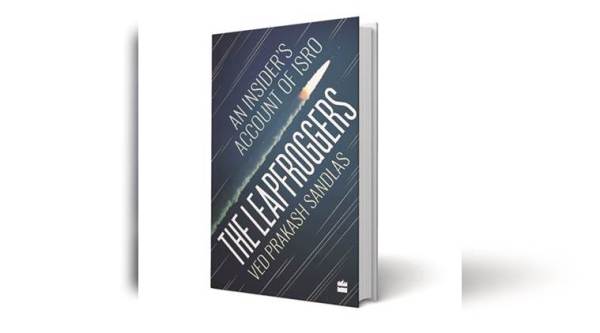The Rocket Man
The legacy of VP Sandlas, the man who helped propel India’s space dreams into orbit in the ’80s

The Leapfroggers: An Insider’s Account of ISRO VP Sandlas HarperCollins 224 pages
On July 18, 1980, India achieved the capability to put satellites into orbit from its own soil, becoming the seventh nation to do so. The rocket that made it possible was SLV-3, a small, relatively simple launch vehicle that carried a spacecraft weighing only 35 kg. It laid the foundations for far more powerful rockets that ISRO would build and successfully fly in later years and also helped establish a technological base for the Agni long-range missiles.
Ved Prakash Sandlas, an electronics engineer who joined the Indian space programme in 1967 and passed away last year, was closely involved with the SLV-3 effort, taking over from APJ Abdul Kalam as its project director after the rocket’s success in 1980. His anecdote-filled account provides an intimate view of over a decade of work that went into the launch vehicle. As with other reminiscences published by long-time ISRO staffers, it puts a human face to the endeavour.
Sandlas vividly sketches his roots and formative years. He was born into a family from a village in Punjab’s Ludhiana district. His father, after school, got a job as a line-man with the Post & Telegraph department in Lahore and secured a transfer to Delhi on the eve of Independence.
He recalls his upbringing: “A one-bedroom house with no toilet or electricity for the first nine years of my life, up to class four, and all through local government school education, followed by merit-cum-means scholarship in college.” After a B.Tech in Electronics and Electrical Communication Engineering from IIT Kharagpur, he joined the Thumba Equatorial Rocket Launching Station on the outskirts of Trivandrum in October, 1967. “My family was quite concerned with my going so far away,” he writes.
At the time, Thumba had quite a small staff and the serial number on his identity card was 68! There are memorable descriptions of settling down, initially as a bachelor and then as a married man, in the Trivandrum of that period, with its small-town outlook.
Sandlas worked initially on electronic systems for the Rohini sounding rockets that were produced at Thumba to replace imported ones. But soon, SLV-3 became the focus of attention at the Vikram Sarabhai Space Centre (VSSC), an entity that encapsulated Thumba and other ISRO units in Trivandrum. SLV-3 was, in Sandlas’s words, “then the most expensive, glamorous and ambitious project of ISRO.” To coordinate the work of many different specialised groups, a Project Core Team was established, and APJ Abdul Kalam was chosen to head it.
The success of SLV-3 catapulted Kalam to national prominence and set him on the path that led ultimately to Rashtrapati Bhavan. Given his exalted stature now, it may be hard to believe that he was by no means an obvious choice to lead the SLV-3 project. There were others in the VSSC hierarchy who were much better educated, with technical accomplishments to show and greater clout in the system. However, as Sandlas notes, “Kalam’s reputation as a manager of technical people and his simple and unassuming nature” stood him in good stead.
Sandlas was brought into the project core team, and his book supplies a compelling tale of the effort that went into getting the project successfully completed. There were tussles and arguments, impossible deadlines, high points and low moments.
The first test flight of SLV-3 on August 10, 1979, failed because a valve in the rocket did not close properly. Satish Dhawan, ISRO chairman at the time, memorably termed the launch “partially unsuccessful”. “We have stumbled a little, but not fallen flat on our face,” he told journalists. He was proven right when SLV-3 succeeded in putting a small Rohini satellite in orbit just a year later.
Kalam moved on to other tasks, and subsequently left ISRO to join the Defence Research & Development Organisation (DRDO) in June 1982. Sandlas became project director of the ‘SLV-3 Continuation Project’ in November 1980. A month later, he submitted a plan for a dozen SLV-3 launches over the next five years, with performance-enhancing improvements. However, only two further launches were approved.
The next launch of SLV-3 took place in May 1981. The countdown had progressed smoothly and uneventfully for one and a half days. Then, with less than a minute to go before lift-off, it was noticed that an umbilical cable supplying external power to the satellite and providing a way to monitor its health had not retracted. The countdown was halted while a technician, who volunteered, climbed up the launch tower and forcibly released the umbilical cable.
Despite this episode, the rocket successfully put the Rohini satellite into orbit. However, its orbit was lower than planned and the satellite plunged back after just nine days. Prime Minister Indira Gandhi came down to Sriharikota to witness the final flight of SLV-3 on 17 April 1983. There were no glitches this time and the launch was a complete success.
The most important assets created by the SLV-3 programme were, Sandlas notes, “the experienced, well-trained and motivated teams of specialists and professional managers who would form the nucleus of all related future national programmes.” A few years after the SLV-3 programme closed, ending a dramatic chapter in the history of the Indian space programme, like Kalam, Sandlas moved to DRDO.
Gopal N Raj is a science writer based out of Thiruvananthapuram






















No hay comentarios:
Publicar un comentario